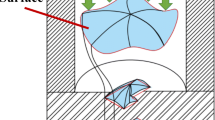Abstract
Bearing region plays an important role in controlling material flow and its optimal design could lead to high quality extruded products. On the other hand, too much of bearing causes the process load to increase. Thus, there must be an optimum point where the bearing lands and the extrusion pressure are just the right values. Determining the proper bearing length is often performed using trial and error methods in the extrusion industry and numerical analysis. The aim of this study is to optimize the bearing length in forward extrusion dies using upper bound method for non-axisymmetric sections. A generalized kinematically admissible velocity field is employed to obtain uniform velocity at the exit surface of the die. Dead metal zone and bearing region define the geometry of the deformation zone. The multi-objective optimization using response surface methodology was applied to optimize the relative extrusion pressure and the deviation of the mean value for the velocity at die exit. Using this method, the proper bearing length is determined. Optimization of bearing land is performed for extrusion of rectangular and L-shaped profiles. The proposed analytical method was verified by physical modelling experiments and numerical simulations. A unique answer for the bearing design could be obtained using the suggested method in a few seconds opposing to numerical method which required many timely and costly trials. This method would be useful for die designers to get the appropriate bearing land and at the same time not to increase the process load excessively.











Similar content being viewed by others
References
Miles N, Evans G, Middleditch A (1997) Bearing lengths for extrusion dies: rationale, current practice and requirements for automation. J Mater Process Technol 72:162–176. https://doi.org/10.1016/S0924-0136(97)00150-7
Nanhai H, Kezhi L (2000) Numerical design of the die land for shape extrusion. J Mater Process Technol 101:81–84. https://doi.org/10.1016/S0924-0136(00)00437-4
Lee G-A, Im Y-T (2002) Analysis and die design of flat-die hot extrusion process 2. Numerical design of bearing lengths. Int J Mech Sci 44:935–946. https://doi.org/10.1016/S0020-7403(02)00030-9
Ajiboye JS, Adeyemi MB (2007) Upper bound analysis for extrusion at various die land lengths and shaped profiles. Int J Mech Sci 49:335–351. https://doi.org/10.1016/j.ijmecsci.2006.08.017
Lin C, Ransing RS (2009) An innovative extrusion die layout design approach for single-hole dies. J Mater Process Technol 209:3416–3425. https://doi.org/10.1016/j.jmatprotec.2008.07.042
Meybodi AK, Assempour A, Farahani S (2012) A general methodology for bearing design in non-symmetric T-shaped sections in extrusion process. J Mater Process Technol 212:249–261. https://doi.org/10.1016/j.jmatprotec.2011.09.010
Gordon WA, Van Tyne CJ, Moon YH (2013) Adaptable dies to minimize distortion in non-axisymmetric extrusions. Int J Mech Sci 77:65–81. https://doi.org/10.1016/j.ijmecsci.2013.09.008
Mayavaram R, Sajja U, Secli C, Niranjan S (2013) Optimization of bearing lengths in aluminum extrusion dies. Procedia CIRP 12:276–281. https://doi.org/10.1016/j.procir.2013.09.048
Nazari Onlaghi S, Assempour A (2015) On the minimization of the exit profile curvature in extrusion through multi-hole dies: a methodology and some verifications. Meccanica 50:1249–1261. https://doi.org/10.1007/s11012-014-0080-1
Viswanath Ammu VNSU, Mahendiran P, Agnihotri A, Ambade S, Dungore PR (2018) A simplified approach for generation of bearing curve by velocity distribution and press validation for aluminum extruded profile. Int J Adv Manuf Tech 98:1733–1744. https://doi.org/10.1007/s00170-018-2364-4
Celik K, Chitkara N (2002) Extrusion of non-symmetric U-and I-shaped sections through ruled-surface dies: numerical simulations and some experiments. Int J Mech Sci 44:217–246
Bakhshi-Jooybari M, Saboori M, Noorani-Azad M, Hosseinipour S (2007) Combined upper bound and slab method, finite element and experimental study of optimal die profile in extrusion. Mater Des 28:1812–1818
Sahoo SK, Sahoo B, Patra L, Paltasingh U, Samantaray P (2010) Three-dimensional analysis of round-to-angle section extrusion through straight converging die. Int J Adv Manuf Tech 49:505–512
Karami P, Abrinia K, Saghafi B (2014) A new analytical definition of the dead material zone for forward extrusion of shaped sections. Meccanica 49:295–304
Tabatabaei S, Givi MB, Abrinia K, Rostamlou M (2015) 3D profile modelling and accurate representation of the deforming region in the extrusion process of complex sections using equi-potential lines method. Int J Adv Manuf Tech 80:209–219
Farzad H, Ebrahimi R (2017) Die profile optimization of rectangular cross section extrusion in plane strain condition using upper bound analysis method and simulated annealing algorithm. J Manuf Sci Eng 139:021006
Qamar SZ, Chekotu JC, Qamar SB (2019) Effect of shape complexity on Ram pressure and metal flow in aluminum extrusion. JOM. https://doi.org/10.1007/s11837-019-03748-6
Johnson W, Mellor PB (1983) Engineering plasticity. Ellis Horwood, London
Razani N, Aghchai AJ, Dariani BM (2014) Flow-forming optimization based on hardness of flow-formed AISI321 tube using response surface method. Int J Adv Manuf Tech 70:1463–1471
Funding
This study was funded by Iran National Science Foundation (INSF) (Grant number 89003323).
Author information
Authors and Affiliations
Corresponding author
Ethics declarations
Conflict of interest
Author Karen Abrinia has received research grants from Iran National Science Foundation (INSF).
Additional information
Publisher's Note
Springer Nature remains neutral with regard to jurisdictional claims in published maps and institutional affiliations.
Rights and permissions
About this article
Cite this article
Seyyed Nosrati, A., Abrinia, K. An analytical approach for the design optimization of bearing land in the metal extrusion of shaped sections. Meccanica 56, 689–704 (2021). https://doi.org/10.1007/s11012-020-01302-2
Received:
Accepted:
Published:
Issue Date:
DOI: https://doi.org/10.1007/s11012-020-01302-2




